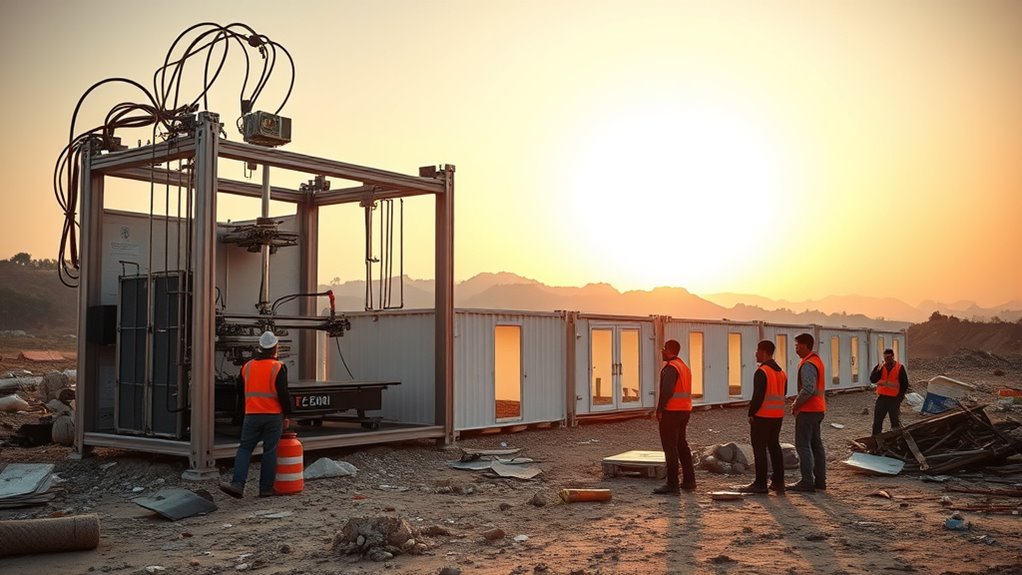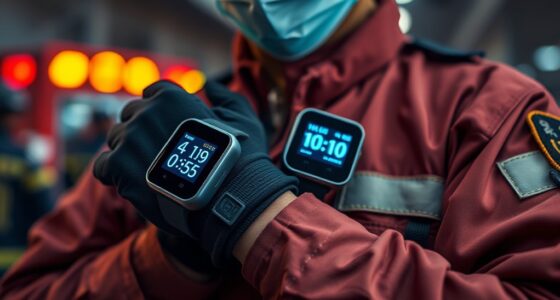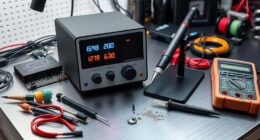3D printing in disaster relief allows you to rapidly produce essential items on-site, such as medical devices, prosthetics, and emergency shelters. It reduces delays, cuts costs, and lets you customize solutions for specific needs. Portable printers can create tools and replacement parts quickly, ensuring you stay efficient during rescue operations. As you explore further, you’ll discover how this technology continues to revolutionize disaster response with smarter, faster building on demand.
Key Takeaways
- 3D printing enables on-site production of essential items, reducing response time in disaster situations.
- It allows rapid manufacturing of personalized prosthetics and medical devices for injured victims.
- Portable 3D printers facilitate quick construction of temporary shelters tailored to environmental needs.
- On-demand printing of replacement parts and tools minimizes equipment downtime during rescue efforts.
- Overall, 3D printing enhances flexibility, speed, and customization in disaster relief operations.

Have you ever wondered how 3D printing is transforming disaster relief efforts? It’s a game-changer, allowing responders to create essential items quickly and on-site, rather than waiting for shipments from distant locations. When disasters strike, access to crucial resources becomes a race against time. 3D printing offers a flexible solution by enabling you to produce custom prosthetics, which can be life-changing for victims who have suffered injuries. Instead of relying solely on pre-made supplies that may not fit perfectly or arrive too late, you can design and print prosthetics tailored to each individual’s needs. This customization not only improves comfort and functionality but also speeds up the recovery process. The ability to produce these devices quickly in the field means you can address medical needs immediately, reducing suffering and helping survivors regain mobility faster. Additionally, understanding reliable power sources and ensuring safety during field operations are crucial for maintaining uninterrupted 3D printing activities in disaster zones.
Beyond medical devices, 3D printing revolutionizes the construction of emergency shelters. Traditional methods often require significant logistics, time, and resources, which can delay aid delivery. With 3D printing, you can construct temporary or even semi-permanent shelters on demand, directly at the disaster site. Imagine deploying a portable 3D printer that uses locally available materials to build shelter structures tailored to the environment and specific needs of the affected community. This approach drastically reduces construction time and costs, making it possible to provide safe, durable housing swiftly. It also offers the flexibility to customize shelters—adding features like reinforced walls or insulation as required—ensuring comfort and safety for displaced populations. Moreover, 3D printing’s adaptability means you can create tools, parts, and replacement components on the spot, reducing dependency on external supplies that may be delayed due to disrupted logistics. For example, if a piece of critical equipment breaks during rescue operations, you can print a replacement part immediately, keeping the relief efforts running smoothly. This on-demand manufacturing capability minimizes downtime and enhances the overall efficiency of disaster response teams. Additionally, the portability of many 3D printers means you can set up mobile units in remote or hard-to-reach areas, bringing essential resources directly to those in need.
3D printing enables rapid, customizable emergency shelters built on-site with local materials, reducing costs and construction time.
In essence, 3D printing empowers disaster relief efforts by providing rapid, customized solutions that adapt to evolving needs. Whether it’s crafting personalized prosthetics or constructing emergency shelters, this technology enables you to respond faster, smarter, and more effectively. It’s a powerful tool that enhances resilience, restores hope, and saves lives in the aftermath of disasters.
Frequently Asked Questions
How Cost-Effective Is 3D Printing for Large-Scale Disaster Relief?
You’ll find that 3D printing can be quite cost-effective for large-scale disaster relief, especially when you compare costs to traditional methods. It offers quick scalability, allowing you to produce essential items on demand. However, be aware of scalability challenges, like equipment costs and resource availability, which can impact overall efficiency. Still, with proper planning, this technology can reduce expenses and speed up aid delivery considerably.
What Materials Are Used in 3D Printing for Emergency Applications?
You might think 3D printing materials are fancy and complex, but really, they’re often simple yet effective. You use biodegradable polymers for eco-friendly projects and composite filaments for added strength and durability. These materials are perfect for emergency applications because they’re lightweight, versatile, and can be quickly sourced or reused. So, in a crisis, your best tools are biodegradable polymers and composite filaments—remarkably adaptable for quick, on-demand solutions.
How Quickly Can 3D Printers Produce Essential Supplies?
You can achieve rapid production of essential supplies with 3D printers, often within hours or days, depending on the complexity. This technology offers great supply chain flexibility, allowing you to quickly adapt to changing needs. By printing items on demand, you reduce delays and reliance on traditional supply routes, ensuring that critical resources like medical tools or parts reach those in need faster during disaster relief efforts.
Are There Any Environmental Concerns With 3D Printing Waste?
Imagine a pile of leftover filament bits—your 3D printer’s waste. You might worry about recycling challenges, but using biodegradable materials helps reduce environmental impact. While 3D printing can generate waste, choosing eco-friendly filaments minimizes harm. You can also develop better recycling methods, turning waste into new supplies. This way, your innovative approach supports disaster relief without adding to environmental concerns, making your efforts both effective and sustainable.
What Are the Limitations of 3D Printing in Remote Disaster Zones?
You might face power supply issues and material scarcity when using 3D printing in remote disaster zones. Limited access to reliable electricity can halt or slow down printing processes, while scarce or unavailable materials can restrict what you can produce. These limitations mean you need to plan carefully, bringing necessary supplies and alternative power sources, to guarantee effective use of 3D printing in emergency situations.
Conclusion
You see, 3D printing transforms disaster relief by providing immediate access to essential supplies. Imagine a community hit by a hurricane, where damaged infrastructure makes traditional aid slow. With 3D printers nearby, you could produce replacement parts or tools on demand, speeding recovery. This adaptability means help arrives faster and more efficiently. As technology advances, your ability to respond swiftly in crises could save lives and rebuild communities more resiliently.










